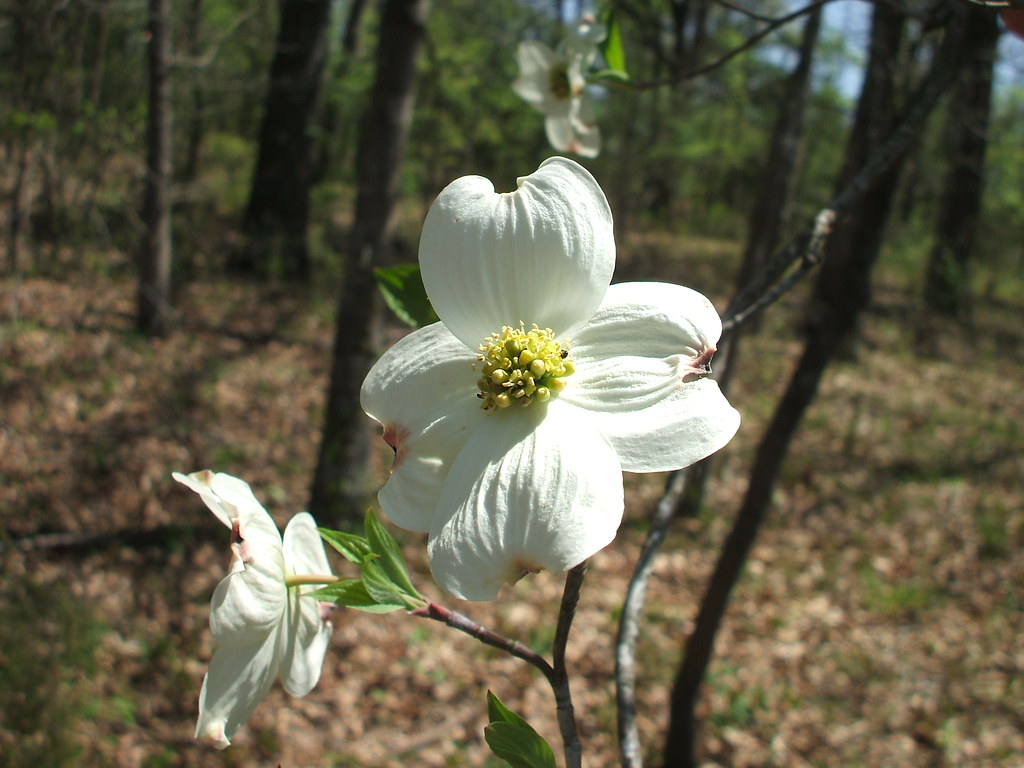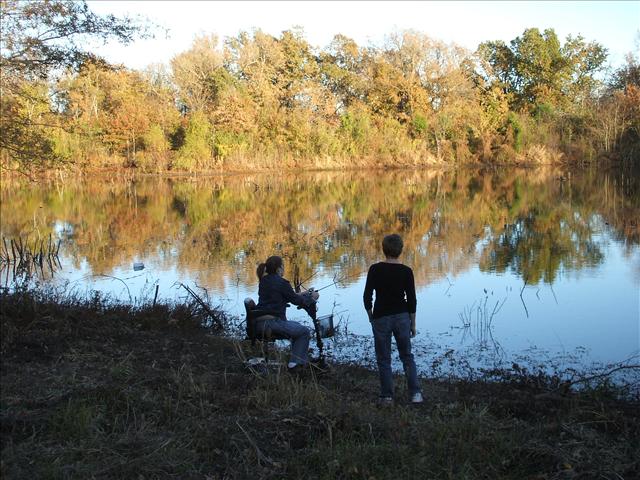Cypress brings images of swamps and huge, moss draped trees. A lot of people do not know that it is a fast growing conifer that works well when planted for a future crop tree. The popular image of the swamp full of bald cypress is because of the tree's traits. It can withstand standing water for long periods of time and resists windthrow, important in soft ground. Cypress is often outcompeted on good sites by hardwoods. It is a component of oak-gum-cypress forests, and is usually only a pure stand where conditions prevent competition from other trees. A cypress planted in good soil will grow quickly, have good form, and self prunes well with proper spacing. The ability for it to grow in poor, water logged soils adds to its crop tree potential. I planted an area the pond floods seasonally with cypress earlier this year. We could not get any information from the local forester in time, so we went ahead and planted 200 with 8'x8' spacing. The idea was to replace some dead oaks with a water tolerant species while adding diversity and a tree useful for timber. The nice look of cypress on a pond helped too. Seedling mortality may jump since the pond has flooded most of them, and we may still have a nutria that likes to eat them. Anybody looking for decent timber production in a flood prone area should consider planting cypress. Here are some sites where I researched my decision:
http://www.sref.info/publications/online_pubs/cypress.pdf
http://www.srs.fs.usda.gov/pubs/ja/ja_parresol014.pdf
http://www.fpl.fs.fed.us/documnts/usda/amwood/218baldc.pdf
Wednesday, April 29, 2009
Monday, April 27, 2009
Mayhaws for problem areas and tasty jelly
The mayhaw is a little known rural South secret. Jelly made from the fruit of this small tree is considered by many to be the best they have ever tasted. Three different species cover a range from east Texas across the gulf and up into the Carolinas and southern Arkansas. An excellent property of this little tree is a tolerance to flooding. How many crops, orchards, or timber producing trees can be grown on flood prone land? The choices are slim, especially if you want trees. I chose to try out 25 saplings near my pond where we did not want to plant cypress. Spring rains flood this area for 6 months out of the year. We chose native mayhaws because we are at the northern range for mayhaws. Hybrid cultivars with larger fruit and harvests are available, but may only be suitable for the deep South in zone 9. I say 'may' because the fruit is such a new commercial crop that long term tests are not complete and new varieties are coming out. Another nice aspect of this tree is that it is adaptable to many environments. It makes the best crop when planted in an orchard on well drained, fertile soil but can also grow in the understory of bottomland forest where it is found in the wild. Ours will be open grown, but with a flood prone, clay soil. I expect larger harvests than in the wild, but similar growth because of the soils. Mayhaws could be a great choice for southern woodlots by providing an edible yearly crop from areas with low site indexes because of flooding and heavy soils. A great source for more information is the Louisiana Mayhaw Association: http://www.mayhaw.org/ .
Wednesday, April 22, 2009
Preserving rare forest types
There are many forest types across the country. Pine/hardwood and Post oak types are fairly common in Texas. It seems like every conceivable mix has a name so it can be categorized and catalogued. The large nutmeg hickory I have has increased my awareness of unusual trees and forests. Evidently, nutmeg hickory is rare and could be at risk of extinction in the future because of it being in mixed forests and rarely in pure stands. The only hickory type we have on the property seems to be nutmeg hickory. I have yet to identify another species of hickory, but I am constantly looking because it seems to associate with shagbark which has a similar bark appearance. I have also figured out that we are at the interchange of post oak forest into the East Texas piney woods. It makes for an interesting mix with lots of nutmeg hickory intermingling with Post Oak Savannah. I like the look of shade tolerant grasses gorwing under the trees, even if they are not Post oaks. Post Oak Savannah is considered a threatened forest type from development and farming practices. It is not considered a valuable timber forest type because of poor tree form and the low stocking levels that let in light for the grasses. I wonder how unusual my forest type is? A threatened type transitioning into a rare type? Texas A&M considers the nutmeg hickory to be important enough to collect specimens from a variety of places for a gene bank. It is the transitional species from pecan hickories to true hickories. I also consider it a beautiful tree worth keeping in my forest. Uneven aged management should provide a wide range of tree sizes to offset any disasters. It also helps that it is a prolific seeder and, with the help of squirrels, provides a good stock of saplings to fill any forest openings. As I make improvements to my forest health, I will allow some of these slow growing, stately trees to have a place. A forest does not need to be a single species or a single age. Here are a few academic sites I found helpful in my search for nutmeg hickory information:
http://aggie-horticulture.tamu.edu/carya/SPECIES/myristiciformis/myristiciformis.HTM
http://aggie-horticulture.tamu.edu/carya/cgc/cgc97.htm
http://aggie-horticulture.tamu.edu/carya/SPECIES/myristiciformis/myristiciformis.HTM
http://aggie-horticulture.tamu.edu/carya/cgc/cgc97.htm
Wednesday, April 15, 2009
Big trees
Everybody is awed by a big tree, but some are bigger than others. I have been trying to track down the biggest trees on my place and judge them against the Texas and national big tree registries. Sometimes it is close and sometimes they fall well short. I think I have a winner this time. Nutmeg hickory is a fairly rare and somewhat smaller tree than other hickories. I have one that was not real close to the state champ. Well, I forgot to look at the little date of measurement which said 1974. A tree must be reconfirmed every 10 years. Another tree has taken its place which is smaller than mine. I also checked the national champ and it looks like mine has a good chance at that one! Time to really get a move on and actually measure some heights and see what my trees really score.
Wednesday, April 8, 2009
The Good, the Bad, and the Ugly
I will go with the bad first. The state forester came out, looked around for 15 minutes, and said manage for wildlife. I was disappointed that the only two aspects he considers important are pine production and wildlife. The main trees I have, oak and hickory, are good for wildlife and hardwood timber. He said that hardwood takes to long so don't mess with it. I figured I would get a response like this, but not one devoid of any help at all. The good news is the folks over at http://www.forestryforum.com/ have been very helpful with their expertise. I have enough book learning to get a plan in place, and the forum members can help me fill in the gaps and problem areas. The ugly comes in two parts. First is a couple of ugly areas of poor form elm overtopping some nice oak and hickory saplings. The forum members helped me a lot by informing me that it would be a good idea to cut out the poorly formed trees and release these seedlings. The second is the ugly bois d'arc trees I found pushed over may not be good for sawing. I cut up the first on into firewood because of a monster heart check 6" wide splitting the trunk. Combined with the regular exterior checking, the log was toast. I have only trimmed off some of the limbs of the second larger one, but it appears it will be the same. They are going to make over a cord of firewood, so we will have a couple years supply of rot proof firewood on hand.
Subscribe to:
Posts (Atom)

